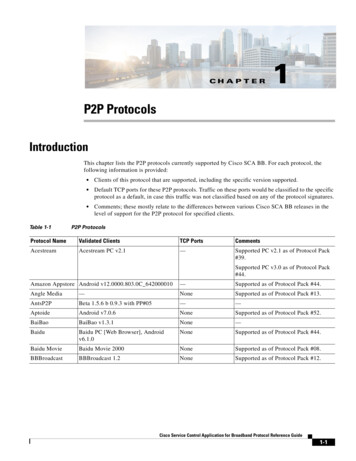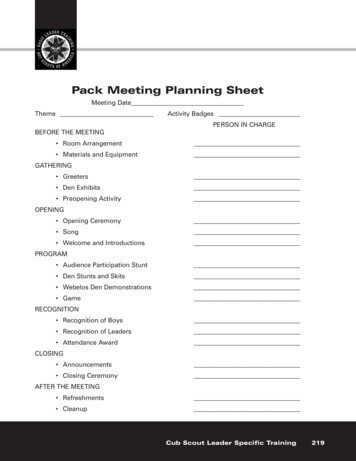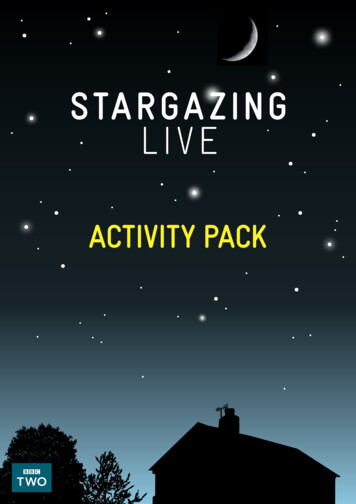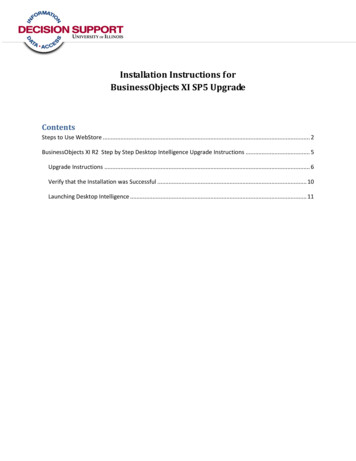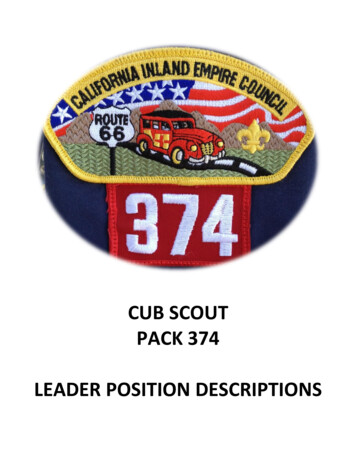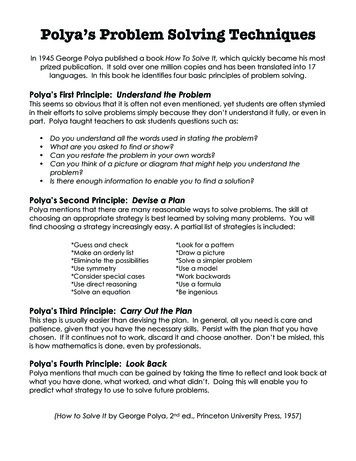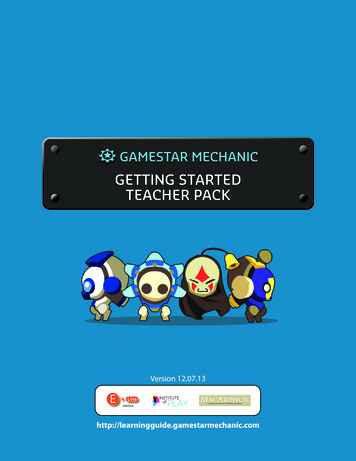
Transcription
GETTING STARTEDTEACHER PACKVersion 12.07.13http://learningguide.gamestarmechanic.com
GETTING STARTEDTEACHER PACKVersion 12.03.08CREATED BY:With Generous Support From:Copyright 2012 by E-line Media and The Institute of Play.All Rights Reserved.
CONTENTSThis Getting Started Teacher Pack will orient you tothe Gamestar Mechanic pedagogy and initial experience.To view this PDF in its digital form:http://tinyurl.com/gsmlg-downloadpackThis information and much more, including lessonsand content to fill over a semester, can be found online ATION1. Introduction1.1 Who Plays Gamestar Mechanic?1.2 Who Teaches with Gamestar Mechanic?1.3 What is the Pedagogy Behind Gamestar Mechanic?1.4 What Skills are Learned in Gamestar Mechanic?1.5 Gamestar Mechanic is a Pathway to Programming1.6 What are the Technical Requirements?12. Approach to Teaching Gamestar2.1 Role of Teachers and Mentors2.2 How to Approach Teaching Gamestar53. Orientation to Gamestar3.1 Registration Screen73.2 The Quests3.2.1 Episodes and Missions3.3 Workshop3.3.1 Toolbox3.3.2 Game Grid3.3.3 Sprite Tray3.3.4 Edit/Play Toggle3.3.5 Tools3.3.6 Level Settings3.3.7 Game Settings3.4 Game Alley3.4.1 Viewing a Game in Game Alley3.5 Spritesi
CONTENTSONLINE LEARNING GUIDE RESOURCESIntroductory MaterialsGuide to the Gamestar Mechanic QuestsAssessmentCreating Content for ClassesClassroom SetupPremium Teacher Features17More LessonsSample Sequences to Dive Deeper into Game DesignLessons on Game DesignLessons using Games Design with Core Curriculum SubjectsChallenge Cards18GETTING STARTED LESSONS202123252729IntroductionLesson 1: Terms and ConceptsLesson 2: Core Design ElementsLesson 3: BalanceLesson 4: DesignLesson 5: Playtest and IterateCheck out the full Learning Guide online BLE MATERIALSElement Cards (For lesson 1)Teacher’s Answer Key (For lesson 1)Core Design Elements Reference Sheet (For lesson 2)Challenge Cards (For lesson 4)Playtester Feedback Worksheet (For lesson 5)ii3243474851
Gamestar MechanicWelcome!Learning Guide WelcomeGamestar Mechanic is a game-based digital learning platform designed to teach theguiding principles of game design and systems thinking in a highly engaging andcreative environment.The Gamestar Mechanic Learning Guide is a curriculum resource for educators, librarians, and parents who wish to use Gamestar Mechanic in formal or informal learningsettings. It provides rich game design content, as well as a set of sample lessons andresources that can be used in conjunction with the Gamestar program.The game and the accompanying Learning Guide are designed tofoster critical 21st century skills such as: System thinking Problem solving Creativity Collaboration Digital media literacies Motivation for STEM (Science, Technology, Engineering and Math) learning1
1. INTRODUCTION1/3The following introduction to the Gamestar Learning Guide describes the audienceof Gamestar Mechanic, both teachers and students, and the pedagogy that informsthe design of the game. We also outline the skills that Gamestar can cultivate, andthe technical requirements that you need to use Gamestar in your classroom.1.1 Who Plays Gamestar Mechanic?The target audience for Gamestar Mechanic is students in the 4thto 9th grade range, but that segment is by no means restrictive.It is designed to appeal to both boys and girls and does not assumeany prior game design or programming experience for the students.1.2 Who Teaches with Gamestar Mechanic?For educators seeking to build a curriculum around GamestarMechanic, there are no requirements for previous study ingame design. The guide introduces all key concepts and theirexternal uses without the necessity for further reading. We haveprovided an optional reading list for educators interested incontinuing their exploration of this emerging field, locatedat the end of the Introduction section.Gamestar Mechanic is suitable for use in a variety of formal andinformal learning environments across the following curriculumareas: 21st Century Skills, STEM Learning, Digital Media, Art,Science and Language Arts.It has been designed to work in both formal and informal learningenvironments including: schools, after-school programs, homeschools, libraries, community centers, tutoring centers, museumsand camps.2
1. INTRODUCTION2/31.3 What is the Pedagogy Behind Gamestar Mechanic?Gamestar Mechanic was designed with the understanding that game design is an activity thatallows learners to build technical, technological, artistic, cognitive, social, and linguistic skillssuitable for our current and future world.The built-in curriculum in Gamestar Mechanic lets learners exercise these skills by creating games.Knowing how to put together a successful game involves system-based thinking, problem solving,collaboration, art, storytelling, and digital media literacy.This Learning Guide offers a flexible curriculum based on prototyping and iteration, a key gamedesign methodology. Students work through multiple versions of any idea or solution, integratingongoing feedback into the learning process, and reflecting on the strengths and weaknessesof their design solutions. The Learning Guide complements and expands upon the curriculumdeveloped in the game itself.Across the curriculum shared by the Learning Guide and the game, students create playful systems—games, models, simulations, stories, etc. Doing so allows students to learn about the way systemswork and how they can be modified or changed. Through designing play, in a context they findcompelling and safe, students learn to think analytically and holistically, to experiment and testout theories, and to consider other people as part of the systems they create and inhabit. Gamedesign serves as the pedagogy underlying this work.3
1. INTRODUCTION3/31.4 What Skills are Learned in Gamestar Mechanic?Systems-Thinking: Students design and analyze dynamic systems, a characteristic activity in boththe media and in science today.Interdisciplinary Thinking: Students solve problems that require them to seek out and synthesizeknowledge from different domains.They become intelligent and resourceful as they learn how tofind and use information in meaningful ways.User-Centered Design: Students act as sociotechnical engineers, thinking about how peopleinteract with systems and how systems shape both competitive and collaborative social interaction.Specialist Language: Students learn to use complex technical linguistic and symbolic elementsfrom a variety of domains, at a variety of different levels, for a variety of different purposes.Meta-Level Reflection: Students learn to explicate and defend their ideas, describe issues andinteractions at a meta-level, create and test hypotheses, and reflect on the impact of their solutionson others.1.5 Gamestar Mechanic is a Pathway to ProgrammingBeyond their value as entertainment media, digital games and game modification are currentlykey entry points for many young people into digital literacy, social communities, and tech-savvyidentities. Because of its emphasis on game design rather than computer programming, Gamestaris a great starter tool for students wanting to learn to make games. Once they have mastered gamedesign’s core concepts and vocabulary, it will be easy for them to move into programming-orientedgame design tools such as Game Maker, Stagecast Creator, or Scratch.1.6 What are the Technical Requirements?To use the Gamestar Mechanic program, there are certain technical prerequisites. Because thesoftware is web-based, the students must have access to at least one computer with Internetaccess permission to contact the www.gamestarmechanic.com site.The computer must also have the Flash 10 player installed, which can bedownloaded from www.adobe.com. If the Flash 10 player is not installed,you will get a prompt to install it automatically upon visiting the frontpage of the program.No additional purchases or downloads are required.4
2. APPROACH TO TEACHING GAMESTAR1/22.1 Roles of Teachers and MentorsTeachers using Gamestar Mechanic in the classroomdo not need to be experts in game design. The built-incurriculum can be used to scaffold a class, with teacherstaking a role of guide and mentor.The lessons in this Getting Started Pack are designed tospur a range of interactions between students andthe game, and students and each other. Teachers shouldserve as facilitators for student discussion, reflection,and ideation.Game design can also empower studentsto teach each other—the act of playingand making games for each other moveslearning into a collaborative sphere.Kids can show other students what theydiscovered by playing and creating games,giving them a chance to act as experts. Werecommend that educators try to supportstudents taking on these roles in theclassroom, serving as teachers andmentors to their peers.5
2. APPROACH TO TEACHING GAMESTAR2/22.2 How to Approach Teaching GamestarThis is a four-part overview of our recommended approach to teachingGamestar in the classroom:The “Getting Started” section of this guide (page 17) presents five lessonsthat follow this sequence. Each lesson takes about one hour to run in full.For more information and lesson plans that dive deeper into game design,go to: http://learningguide.gamestarmechanic.com.6
3. ORIENTATION TO GAMESTAR1/10This orientation is a guide to getting around Gamestar Mechanic as a site and game.Gamestar Mechanic has three sections: The Quests, Workshop, and Game Alley. The Quest is a single player storyline where students earn sprites,the components that they use to make their games. The Workshop is where students make their own game. Game Alley is where students share games in an online community.3.1 Registration ScreenBefore using Gamestar Mechanic, you and your students will need to go through the registration process.STEP 1STEP 2New users must go through a three-step registration process, the third of which is the receiptof an email with an activation link to complete the registration process.To register a large number of students:1. Create an account for yourself at: www.gamestarmechanic.com.2. Create an institution at www.gamestarmechanic.com/teachers/setup.3. Have your students create their own accounts using the link provided to youduring the institution setup.If you sign up students using the link provided to you, they will not need to enteran email address of their own.If you want a Premium Teacher account, email: educators@gamestarmechanic.com.7
3. ORIENTATION TO GAMESTAR2/103.2 The QuestsThe Quests section contains the “story” of Gamestar Mechanic.Cast as a young aspiring game designer, the player is pulledinto an exciting tale of adventure and discovery.In the Quests, mechanics learn about differentSprites and their behavior, and upon finishingeach game, they are awarded Sprites to usein their Toolbox.8
3. ORIENTATION TO GAMESTAR3/103.2.1 Episodes and MissionsA Quest is divided into Episodes. Eachepisode covers a lesson in game design,taught over a number of Missions, in oneof three types: Play, Repair, and Build.This sequence shows the player an elementof game design in action, then asks themto fix a game and finally lets them build agame around that topic.An episode begins and ends with a comicthat sets the scene.STORY MISSIONSPlay Missions require the user to successfully complete the play of a pre-designed gameby accomplishing the set objectives. Play Missions usually serve to introduce users to thebehavior of Sprites.Repair Missions present the user with a game that is in some way broken and cannot besuccessfully played. The user must deduce what is broken about the game and use theGamestar Mechanic console to place or remove objects. A set of requirements will bepresented that the repaired game must include, such as “Place 10 enemies.” The missionis completed when the player has successfully played and accomplished the objectivesof the repaired game.Build Missions present the user with a blank slate to build a new game on. A set ofrequirements will be presented that the game must include, such as “Place 10 enemies. ”The mission is completed when the player has successfully played and accomplished theobjectives of their created game.BONUS MISSIONS & REWARDSBonus Missions are either Play Missions, Repair Missions orBuild Missions and do not need to be completed to continuein the Quest.After each mission, story or bonus, is completed, the player isrewarded with sprites and other rewards such as backgroundsand music to use in their Toolbox.9
3. ORIENTATION TO GAMESTAR4/103.3 WorkshopThe Workshop is where playersdesign games with their Toolboxand Sprites. Each player startswith a default set of Sprites andearns more as he/she advancesthrough the Quest. Players alsohave Template Games that includesets of Sprites that come with theTemplates.Edit/Play ToggleToolbox3.3.1 ToolboxSettingsToolsSprite TrayThe Toolbox is the free-form gamecreation area of Gamestar Mechanic,where users can build new gamesfrom scratch. The Toolbox has fourcomponents: Game Grid, Sprite Tray,Tools, and Settings.3.3.2 Game GridGame GridThe Game Grid is the work area whereplayers create their own games.10
3. ORIENTATION TO GAMESTAR5/103.3.3 Sprite TrayThere are two main sections in the Sprite Tray:At the top of the Sprite Tray, Levels in the current game aredisplayed. The player can move freely between levels to edit them.Clicking and dragging the level name to a new position within thewindow allows players to reorder the levels in their game.The Sprite Tray also contains all of the player’s Sprites.Sprites are the essential building blocks of Gamestar Mechanicgames. As players proceed through the Quests (in-game curriculum), they are awarded new Sprites to use in their games.Once a player has earned a Sprite, it can be used an unlimitednumber of times.Earned sprites appear in their Work Area inventory. The moreadvanced a player is, the more Sprites they will have to buildgames with.Toolbox11
3. ORIENTATION TO GAMESTAR6/10Edit/Play Toggle3.3.4 Edit/Play ToggleThe Edit/Play Toggle switch at the top of the Sprite Traycontrols the behavior of the console.In Edit mode, the game is not “playing”—everythingstands still.In Play mode, the mechanic can test that their game isworking as intended.We recommend encouraging designers to test theirgames frequently.Editor Tools3.3.5 ToolsWhen the Arrow button is selected, designers can drag Sprites out of their Inventory to the grid, as well as pick up and drop sprites that have been placed.The Wrench button allows designers to change the parameters of the Sprites theyhave placed. Each Sprite has an individual set of parameters that govern its behavior.These parameters include things like movement speed, damage, point value, etc.The Eyedropper button allows designers to copy Sprites that are placed on the grid.This is especially useful when the designer has changed the parameters of the Spritewith the Wrench tool, because using the Eyedropper will create a clone of the Spritewith the changed parameters. This makes it easy to duplicate customized Sprites.The X button allows designers to delete Sprites placed on the playfield. This actionis permanent.12
3. ORIENTATION TO GAMESTAR7/103.3.6 Level SettingsEvery game is composed of one or more Levels.A level is a self-contained unit of gameplay witha defined goal. Think of this window as definingthe “world” that the game takes place in. TheLevel Settings are used to control the overallqualities of the game space, including the perspective of the camera and the size of the level.Users can choose and adjust a variety of parameters that define this space. The first three fieldsin the Level Settings window allow the user tocreate a name for the level, write text that is displayed when a player begins playing the level,and write text that is displayed when playerscomplete it.Multiple Screen means the game screen willmove with the player, revealing previouslyunseen areas as they move towards the edges.Choosing Multiple Screen opens up a submenuthat lets users determine the total size of theplaying field, up to a grid of 10 screens wideby 10 screens tall.The Perspective of a Level indicates whetherthe Player is viewing the play field from eithera “top-down” or “platformer” perspective. In theplatformer perspective, the player controls anavatar that jumps from platform to platform.In top-down perspective, the player controlsan avatar seen from above, which can movein all four directions.Choosing “platformer” perspective opensup a Gravity submenu. Gravity determinesthe amount of downward force placed onmoving Sprites in the game. Increasingthe gravity increases the speed at whichobjects fall, decreasing it allows avatarsprites to jump higher and fly.Edge Bounding determines how the edgesof the playfield behave. Some edges can stopthe player’s motion or allow the player to passfreely. In platformer perspective, if the playerfalls off of the edge of the screen, they willautomatically lose the game.Background and Music let the user choosefrom background art and musical themes (orsilence) that will play during the level. Players start with a few of these and earn morethroughout the Quests. To see where in theQuests the backgrounds and music areearned, go to the Quest Guide:Single Screen means the game is restrictedto the size of one visible game screen—a 16 x 12 grid of Sprites. We recommend starting out with this setting, as it can help focusnew game designers.Choosing single screen opens up a Wraparound submenu. Wraparound meansthat when the player leaves one edge ofthe playfield, her avatar will reappear atthe opposite edge.http://tinyurl.com/gsmlg-intro-questguide13
3. ORIENTATION TO GAMESTAR8/103.3.7 Game SettingsDesigners use Game Settings to write the text thatplayers will see. This includes: the Game Name; theGame Intro text which appears when the game isfirst opened; the Game Win Message that appearsat the end of a game.There are two other settings here which are good forteaching writing skills. The “Goals and Rules” is a textarea where players can write what their game is about,and it is good for communicating the metaphor of acreative game.The “Tips and Tricks” is a good place for designers tothink about what their players need to know, and topractice didactic writing skills.3.4 Game AlleyOnce games are published, they appearin Game Alley for other Mechanics andvisitors to the site to play.At the top of the Game Alley screen is the“Featured Challenge,” which spotlights adesign challenge that designers can taketo demonstrate their design skills withina carefully chosen set of design goals.14
3. ORIENTATION TO GAMESTAR9/10The Search Bar lets players look for games by title or byuser name. The screen also displays categories of gamessuch as “Featured”, “Popular” or “New”.The Channels are curated collections of games aroundthe theme.3.4.1 Viewing a Game in Game AlleyGame Alley is also where players can review or comment on eachother’s games and provide helpful critical feedback as part of theiterative design process. These reviews have both Ratings andsimple Review Headings to guide feedback.Players can share a game by linking the game, emailing it,embedding it in another website, or marking it as a favorite.Sharing a game will make that game available even to peoplewho are not logged in to Gamestar Mechanic. Players can showtheir games to their parents and friends, even if they don’t haveGamestar Mechanic accounts.Reviews and comments are moderated. Kids willinevitably make inappropriate comments on eachother’s games.The flag button will allow you to report unacceptablecomments to us.15
3. ORIENTATION TO GAMESTAR10/103.5 SpritesSprites are the componentsthat you can place on thework area. Use the wrenchtool to change the settingsof a sprite: speed, health,movement patterns, etc.Sprites are divided into five basic groups:Avatar Sprites are the objects in the game that are under direct controlby the player. Only one Avatar may be placed in the playing area at a time.When the game is played, the arrow keys on the keyboard and the Spacebar control the Avatar. Left-handed students can use the WASD keys tocontrol Avatars as well.Enemy Sprites are objects that exist to hinder the player’s progress bycausing damage to the Avatar. Enemies come in a variety of types, andeach one has a number of settings that determine its behavior.Block Sprites are used for creating the environment of games. They donot move once they are placed in the playing area. Most blocks are usedto create terrain for the player to explore—mazes to sneak through, platforms to jump on, and obstacles to hide behind.Item Sprites are objects that the Avatar can collect and is rewarded by.They can modify the behavior of the Avatar by granting it new abilities,as well as modifying System sprites. For instance, when you pick up thetime bonus you will earn extra time to complete the level.System Sprites control aspects of the game, including monitoring thewinning conditions for each Level. They are not physical objects in thePlay Area, but rather sit above the game space and monitor what is going on inside, providing feedback to players on their play. For example,the point counter keeps track of the player’s collected points.16
ONLINEGAMESTAR MECHANIC1/3Online Learning Guide ResourcesCheck out Gamestar Mechanic’s Online Learning Guideto find more information on teaching with Gamestar,lesson plans, and activities.The Online Learning Guide: Provides material for a semester-long curriculum, offering 30 lessonsthat dive deeper into game design. Has 24 lessons on using game design with core curriculum subjects. Contains Sample Sequences that divide the lessons into categoriesof Game Design, Art and Storytelling, and STEM.We recommend that you first complete the fiveGetting Started Lessons in this guide, and thenmove on to the Sample Sequence that bestsuits your class.The chart below provides more informationon what you can find in the Online LearningGuide:Introductory MaterialsURLGuide to the Gamestar Questshttp://tinyurl.com/gsmlg-intro-questguideThe Gamestar Mechanic Quest is an adventuregame with a rich story told through motioncomics and games which students play, fix, andbuild. The episodes of the adventure follow thepedagogy described in the “Getting Started”Lesson Sequence.Your students are going to play through the questas a single-player game and to earn tools for building their own games. The online Quest Guide forteachers provides a summary of what you earnthrough the Quest, what students will learn aboutgame design, and the o-assessmentHere we provide criteria on what constitutes aneffective design process, and criteria for goodgames. We also provide methods to help youassess your students, or have your studentsassess themselves.17
GAMESTAR MECHANIC2/3Online Learning Guide ResourcesCreating Content for Classeshttp://tinyurl.com/gsmlg-intro-ccfcThis is a list of methods teachers and facilitatorscan use to create content for group activitiesusing Gamestar Mechanic and strategies forfostering a design community.Classroom Setuphttp://tinyurl.com/gsmlg-intro-setupHere are some tips on establishing groupwork in Gamestar Mechanic.Premium Teacher Featureshttp://tinyurl.com/gsmlg-intro-ptfHere are explanations of three features thathelp you manage your class included in Premium Teacher accounts: Student Tracking,My Class, and Stats.This section provides more lessons that dive deeper into game design.More LessonsURLSample Sequences to Dive Deeper into Game e sequences are divided into different disciplines:game design, art and storytelling, and STEM topics.Choose the sequence that is most appropriate foryour class.Lessons on Game Designhttp://tinyurl.com/gsmlg-more-logdThis section includes over 20 lessons on game design.Because these lessons dive into game design in detail,we recommend that you first cover lessons 1 to 5 in thisGetting Started Teacher Pack before moving on tothese lessons on game design.Lessons Using Game Design withCore Curriculum ese lessons showcase ways of connectingtraditional academic content to game creation.Principles of game design are connected to lessonson math, science, literature, social studies, and art.18
GAMESTAR MECHANICOnline Learning Guide ResourcesMore Challenge dsChallenge Cards create a series of jumping off pointsfor students in the creation of games. The cards canbe photocopied and cut out to create decks for usein the classroom. Four challenge cards have alreadybeen provided for you in this Getting Started TeacherPack (see Lesson 4), but you can find many more online!19
Gamestar MechanicLESSONSIntro to the Five Getting-Started LessonsThe following five lessons serve as an introduction to GamestarMechanic and to game design in general.These five lessons can be taught as a stand-alone course, or as an introductionto a larger course on game design. Lesson 1: Terms and Concepts Lesson 2: Core Design Elements Lesson 3: Balance Lesson 4: Design Lesson 5: Playtest and IterateAfter completing these five lessons, students will be able to: Correctly use terms and concepts to describe aspects of game design Identify and define the five elements of game design Design balanced games that are both fun and challenging Playtest and effectively give feedback each other’s games Iterate on their games incorporating feedbackFor a full course that provides content that dives deeper into gamedesign, visit the Online Learning Guide at:http://learningguide.gamestarmechanic.comThe Online Learning Guide supplies the introductory lessons that are in this pack,as well as lessons and activities that provide more than enough content for an entiresemester on game design.20
LESSON 1: Terms and Concepts1/2LOCATION: Computer LabAt the end of this lessonstudents will be able to:Gamestar Episodes relatedto this lesson:Acquire and apply concepts aboutthe elements of a game.First Quest - Episodes 1 and 2What’s On For Today?1 Set-up (5 minutes)Through the play and analysis of GamestarMechanic, students will learn the namesand concepts behind the basic elementsof a game.1. Explain to students that they will be playingGamestar Mechanic, a game that will teachthem how to design games. The first step tobecoming a game designer is playing games!Students will complete a matching game thatconnects the images in Gamestar to the termsused to describe the game.2. In the computer lab, have the students log-into Gamestar Mechanic.Materials Included: Element Cards, pictures and descriptions.(one set per group) Element Card Answer Key* The above materials can be found under the“Printable Materials” section of this GettingStarted Teacher Pack on page 32.Pacing:Total Time: 1 hour, 10 minutes21
LESSON 1: Terms and Concepts2/2LOCATION: Computer Lab2 Play - Gamestar Mechanic (30 mins)4 Discuss (15 minutes)1. Allow students to play through the firstGamestar Mechanic quest, episodes 1 and 2.1. Ask students if there are any terms that areunclear and elicit definitions.They can play individually or in partners.If they play in partners, make sure they taketurns playing the games.Some terms that are more difficult to definemay be: scrolling space, wraparound space,unbounded space, environmental vs.damage block.Encourage the students to help each otherand ask each other questions if they havetrouble with a level.New words may be: avatar, frag counter.2. After 30 minutes, have students finish up.If they did not finish episodes 1 and 2,encourage them to finish after class orfor homework.5 Circle Up (5 minutes)1. Ask the students: how was your firstexperience with Gamestar Mechanic?3 Play - Element Card Game (15 mins)2. What part of the game was most fun?Most difficult?Encourage students to use the new termsthey learned from the Element Cards whilediscussing their experience.1. Divide students into groups of 3 or 4.Hand each group a set of element cards(both pictures and names).How did it go?Were students able to identify some ofthe key terms describing the systemof a game?2. Tell the groups to match the image to itscorrect title. (You can choose to make thisactivity into a race and declare the group whofirst matches all the cards correctly the winner).Were students able to completethe Element Card MatchingGame?3. Check their answers with the Element CardAnswer Key.22
LESSON 2: Core Design Elements1/2LOCATION: Computer LabAt the end of this lessonstudents will be able to:Gamestar EpisodesRelated to this lesson:Recognize games asdynamic systems.First Quest - Episodes 3 and 4What’s On For Today?1 Warm-up (10 minutes)1. In the Gamestar quest, direct the studentsto the introduction of Episode 3. The introduction of each lesson is the comics thatprecede the lesson.To understand games as systems, studentsmust be familiar with the elements of a system.Students will discuss the Core Design Elementssheet, identifying examples for each elementfrom Gamestar Mechanic.2. Have the students read the comics, thenask them for the five elements of gamedesign that were mentioned (mechanics,space, goals, rules, and components).Students will explore a game system by editingthe Change the Element template game.Materials Included:3. Hand out the Core Design Elementsworksheet. Tell students to keep thisworksheet with them for reference. Core Design Elements reference sheet(Make a copy for each student)* The above reference sheet can be found under2 Play (30 minutes)the “Printable Materials” section of this GettingStarted Teacher Pack on page 47.1. Have students play through Episodes 3and 4 of Gamestar Mechanic.Pacing:2. After 30
Gamestar Mechanic Learning Guide Welcome Gamestar Mechanic is a game-based digital learning platform designed to teach the guiding principles of game design and systems thinking in a highly engaging and creative environment. The Gamestar Mechanic Learning Guide is a curriculum resource for educators, librar- ians, and parents who wish to use Gamestar Mechanic in formal or informal learning


